Trek’s Rail 9.8 electric mountain bike is the brand’s longest 160mm-travel, full-power 29in-wheeled electric mountain bike, designed for the toughest types of riding.
Its frame is made from Trek’s Optimum Compaction Low Void (OCLV) carbon fibre, where Bosch’s 750Wh removable side-loading battery is hidden inside the down tube. It powers Bosch’s Performance Line CX electric bike motor, boasting 85Nm of torque.
This mid-level model has a Shimano M8100 XT 12-speed drivetrain and XT four-piston brakes. Its RockShox rear shock uses Trek’s proprietary ThruShaft tech, claimed to improve performance, and is matched to a ZEB fork.
Although a newer, more expensive Gen 4 model (£10,075) of the Rail 9.8 XT is now available, bar the different Bosch Mini Remote and System Controller that replace the LED remote and Kiox 300 display on the Gen 3, and different colour schemes, no other changes have been made.
Trek Rail 9.8 XT Gen 3 frame, suspension and motor

The Rail’s OCLV Mountain carbon fibre has been developed with durability and strength in mind, resulting in the chunky 1.8in ebike fork-steerer compatible head tube and oversized 34.9mm-diameter seat tube.
Trek’s Knock Block headset is fitted, stopping the bars from over rotating and potentially damaging the bike’s top tube, or brake or gear cables.
Its cables are routed internally with integrated guides, entering the frame via ports on the down tube and exiting close to the derailleur and rear brake. There are water bottle cage and accessory mounts within the front triangle.
Chain-slap protection is fitted to the driveside chainstay and the Boost 148 rear-axle spacing is matched with SRAM’s Universal Derailleur Hanger.
Using Trek’s Active Braking Pivot (ABP) – where the seat-to-chainstay pivot is concentric with the rear wheel’s axle – the Rail has 160mm of travel. Trek claims this design improves on-the-brakes suspension performance.
ABP is combined with a ThruShaft shock, co-developed by Trek and RockShox. This, the brands claim, is the most responsive shock on the market thanks to fewer seals and the lack of an internal floating piston, where the damper shaft actually ‘exits’ from the bottom of the shock.
Bosch’s Smart System Performance Line CX motor is powered by the brand's 750Wh battery. Bosch’s colour Kiox 300 display is fitted to the top tube, offering ride data and navigation functionality.
Trek Rail 9.8 XT Gen 3 geometry

Thanks to Trek’s seatstay rocker pivot adjustable Mino Link, the Rail has two geometry positions. Changing the flip chip’s position adjusts the head angle between 64.2 and 64.6 degrees and lowers the bottom bracket by 5mm, from 346mm to 341mm.
It’s available in four sizes from small to extra-large, each bike running on 29in wheels. Fitting a 27.5in rear wheel is also possible; the Mino Link’s adjustment can compensate for a mullet setup. Its seat tube angle is 76.7 degrees (low) or 77.1 degrees (high) depending on the Mino Link’s position.
Chainstay lengths also change depending on flip chip position by 1mm between 447mm (low) and 448mm (high) for all sizes.
Elsewhere reach figures start at 432mm for the small and lift to 521mm for the extra-large, with this size large test bike’s figure sitting at 487mm.
Like many modern electric enduro bikes, these geometry figures appear to be converging on a cross-brand sweet spot.
| | S | M | L | XL |
|---|---|---|---|---|
| Low / High | Low / High | Low / High | Low / High | |
| Seat angle (degrees) | 76.7 / 77.1 | 76.7 / 77.1 | 76.7 / 77.1 | 76.7 / 77.1 |
| Head angle (degrees) | 64.2 / 64.6 | 64.2 / 64.6 | 64.2 / 64.6 | 64.2 / 64.6 |
| Chainstay (mm) | 448 / 447 | 448 / 447 | 448 / 447 | 448 / 447 |
| Seat tube (mm) | 410 | 420 | 450 | 500 |
| Top tube (mm) | 580 / 579 | 601 / 600 | 639 / 638 | 673 / 671 |
| Head tube (mm) | 105 | 110 | 125 | 140 |
| Fork offset (mm) | 43 | 43 | 43 | 43 |
| Trail (mm) | 13 | 12.3 /13 | 12.3 /13 | 12.3 /13 |
| Bottom bracket drop (mm) | 3.3 / 2.7 | 3.3 / 2.7 | 3.3 / 2.7 | 3.3 / 2.7 |
| Bottom bracket height (mm) | 341 / 346 | 341 / 346 | 341 / 346 | 341 / 346 |
| Wheelbase (mm) | 1,214 / 1,213 | 1,236 / 1,236 | 1,278 / 1,277 | 1,314 / 1,313 |
| Standover (mm) | 756 / 761 | 768 / 773 | 765 / 770 | 763 / 768 |
| Stack (mm) | 628 / 625 | 633 / 629 | 626 / 643 | 660 / 656 |
| Reach (mm) | 432 / 436 | 452 / 456 | 487 / 491 | 517 / 521 |
Trek Rail 9.8 XT Gen 3 specifications
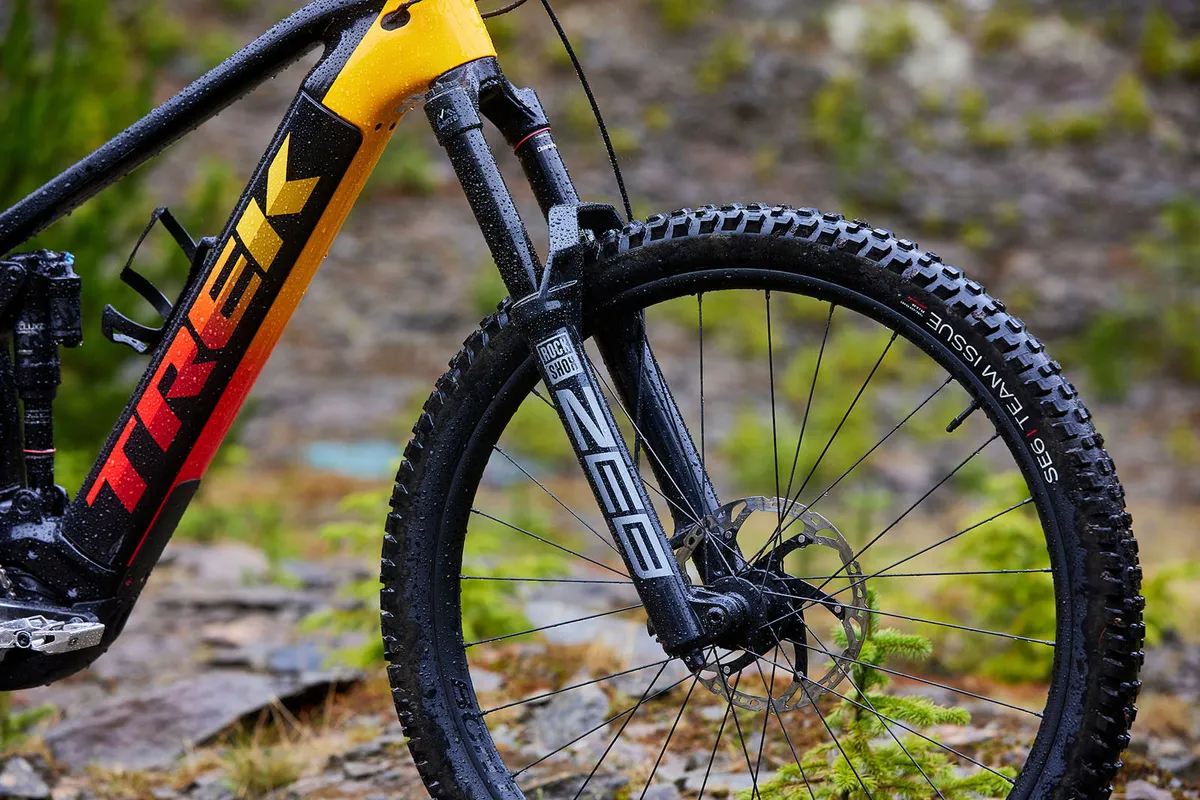
The 160mm-travel RockShox ZEB Select with external low-speed compression and rebound adjustment is matched to a Super Deluxe Ultimate RT2 ThruShaft rear shock, with external low-speed rebound and compression adjustment, and a threshold climb lever.
A full 12-speed Shimano XT M8100 drivetrain is matched with e*thirteen E*spec cranks and chainring. Also from the Shimano stable are XT M8120 four-piston brakes with 203mm disc rotors front and rear.
Trek's house brand Bontrager supplies the Line Comp 30 wheels wrapped in Bontrager SE5 (front) and SE6 (rear) 29x2.5in tyres.
Also from Bontrager is the Arvada saddle, Line Elite Dropper with 170mm travel, Line Pro OCLV Carbon handlebar, Line Pro stem and XR Trail Elite grips.
This size-large test bike weighs 23.97kg without pedals.
Trek Rail 9.8 XT Gen 3 ride impressions
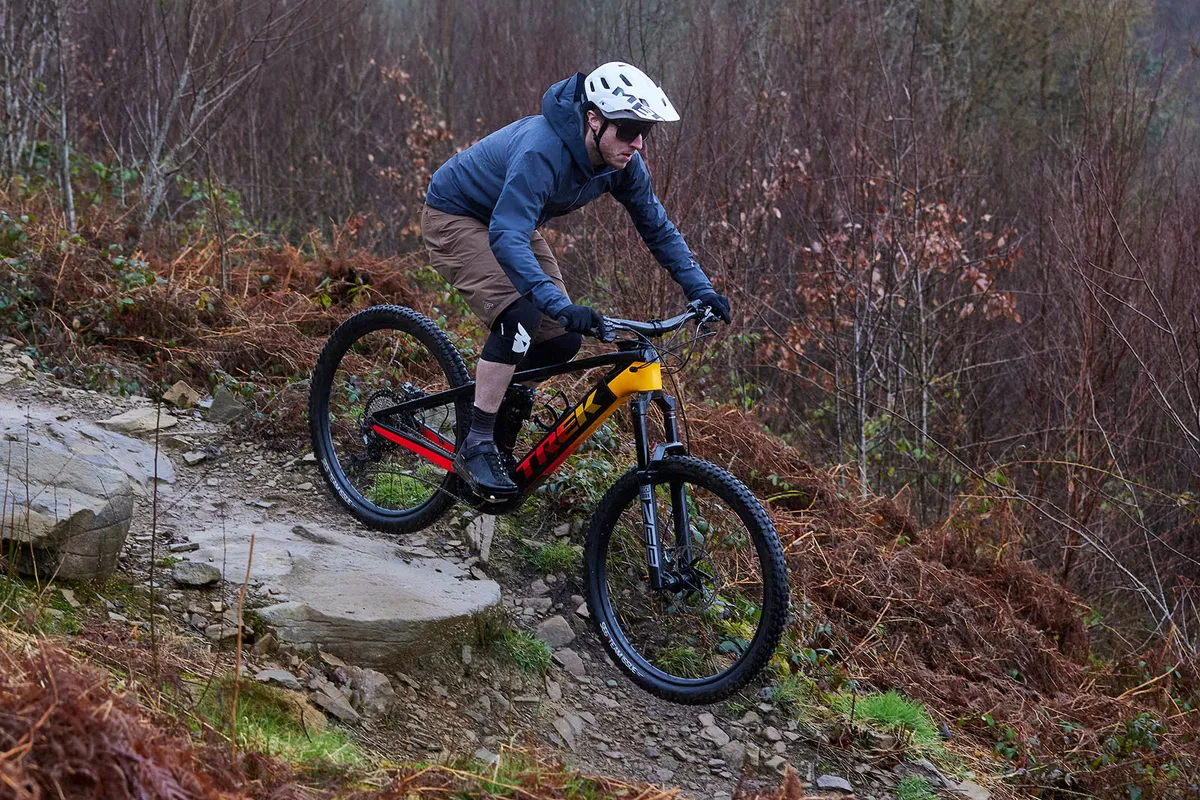
I tested the Trek Rail 9.8 XT Gen 3 on the trails in Scotland’s Tweed Valley, home to the UK’s round of the enduro world cup.
Conditions ranged from freezing cold winter through to mild, dry spring-like riding, with everything in between.
Setup
Using Trek’s recommended settings, I inflated the ZEB fork to 74psi, giving me 20 per cent sag. I left the two factory-fitted volume-reducer spacers installed. I left the low-speed compression adjuster in its fully open position and set the rebound to taste.
I inflated the rear shock to the recommended 215psi, giving 28.7 per cent sag, and left the single blue volume-reducer spacer installed in the air spring. I set the low-speed compression to its fully open position and set rebound to taste.
I left these settings unchanged for the duration of the test period.
Trek Rail 9.8 XT Gen 3 climbing performance
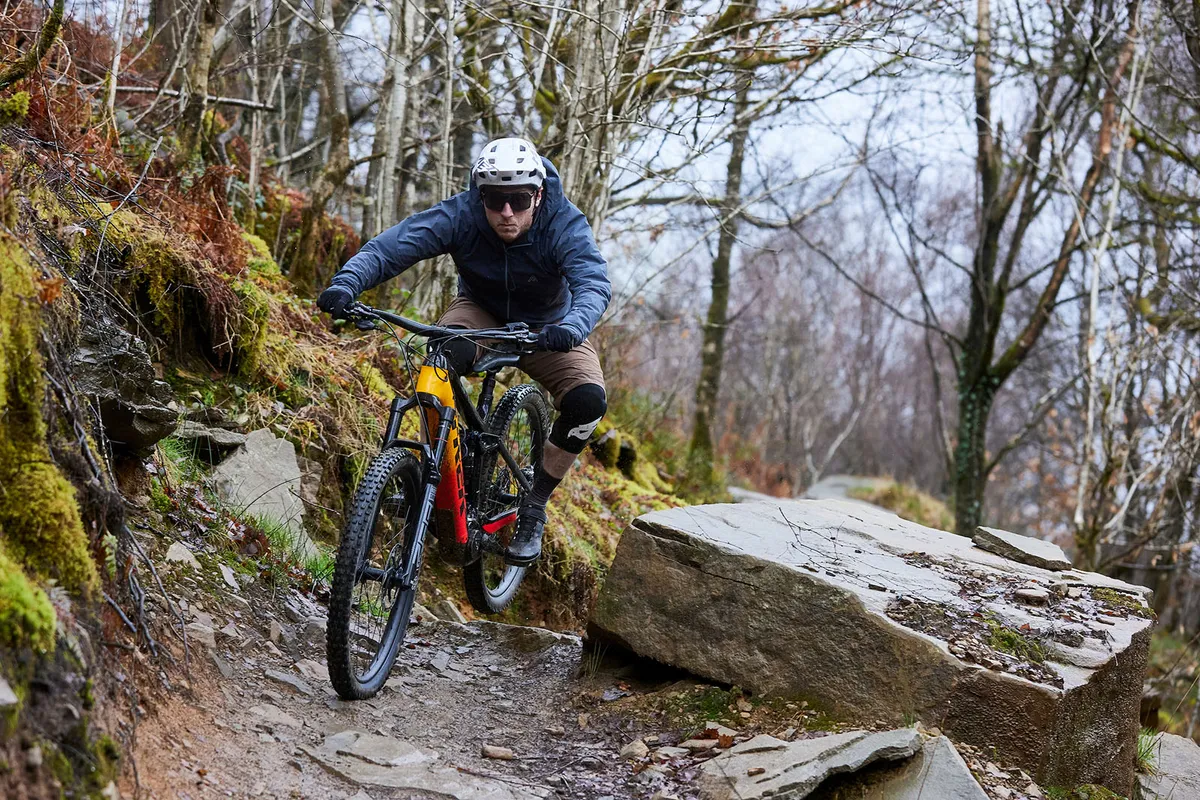
The Rail’s suspension flutters in and out of its travel impeccably, actively smoothing worn trail-centre style surfaces, helping generate grip and comfort.
Trek’s ThruShaft technology clearly contributes to the rear end’s smoothness thanks to a lack of friction, but the shock’s light-feeling damper tune is also at play.
However, the Trek’s overall feel is rough and raw.
High-frequency, low-amplitude bumps get reverberated through the bars and saddle, and not because the RockShox ZEB or Super Deluxe can’t absorb them quickly enough, but because the frame, wheels, tyres and handlebars culminate in a stiff-feeling, rather direct ride.
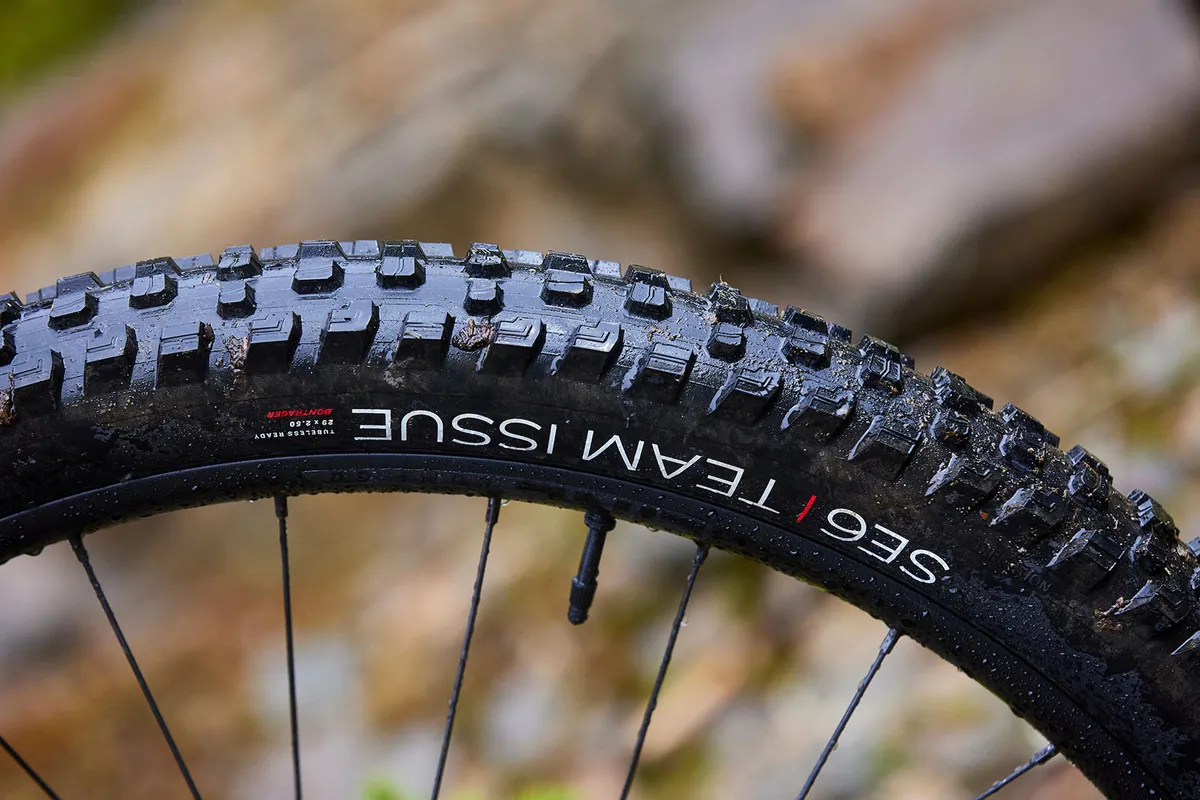
Reducing tyre pressures claws back some comfort, but the relatively feeble casings of the SE5 and SE6 tyres means puncturing becomes a real risk, and unwanted carcass deformation occurs regularly. A balance is tricky to find here, so opting for the safer, higher pressures seemed sensible.
Trek’s TM-Grip compound, found on both the Rail’s tyres, feels hard. It rolls fast, but lacks the softness to stick to wet, greasy rocks, roots or hardpack dirt.
On the back wheel, this results in increased wheelspin. At the front, it impacts steering confidence and accuracy even at low speeds while climbing, as the tyres slide and squirm across anything other than bone try trails.
It’s not all bad, though.
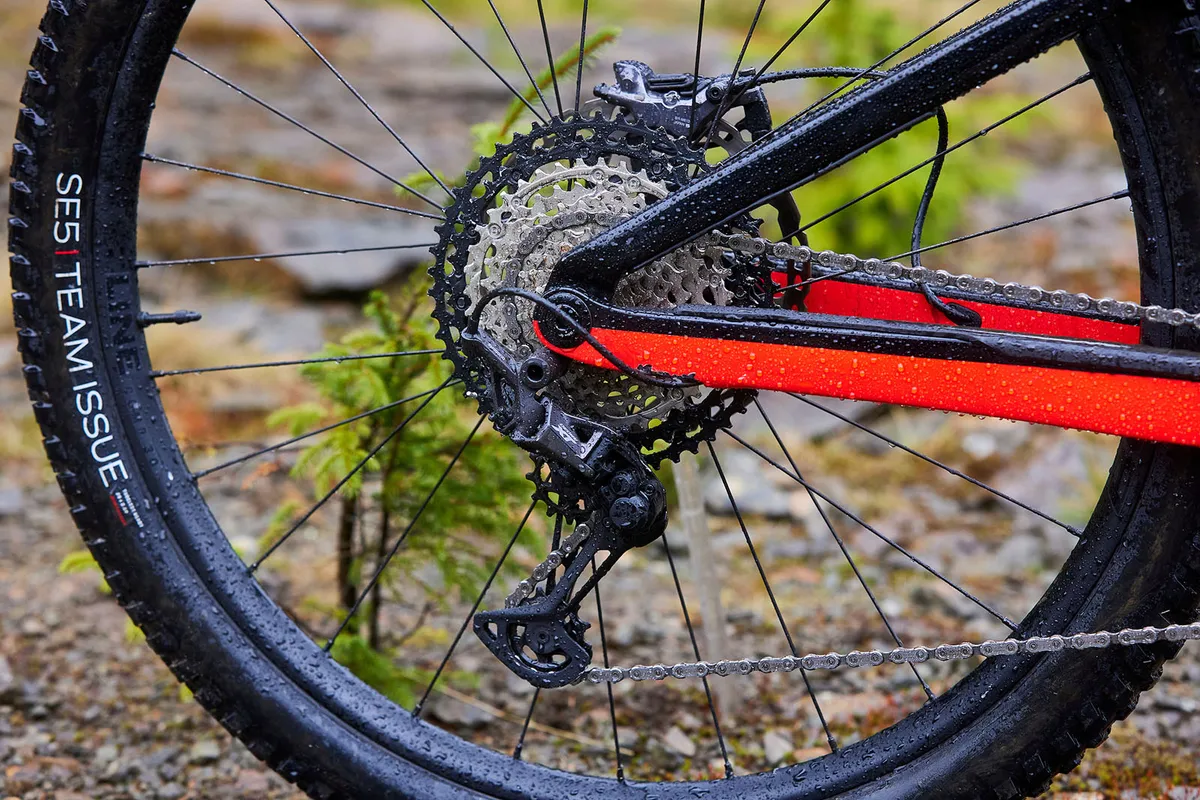
The Rail’s steep seat tube angle places your hips directly above the motor, improving pedalling efficiency and comfort.
Its high stack and well-sized top tube combine with the seat tube angle, creating an upright seated position. Rider weight is focused through the saddle rather than the hands, helping reduce fatigue and alleviate some of those comfort issues by the overall stiffness.
The riding position is very neutral. On steep ascents, front-wheel lift is limited and you won’t have to move frequently onto the saddle’s nose to keep it down.
Likewise, this helps maximise the grip the rear tyre can muster, but wheelspins are more likely than not if there’s a hint of moisture on the ground.
Motor performance and battery life
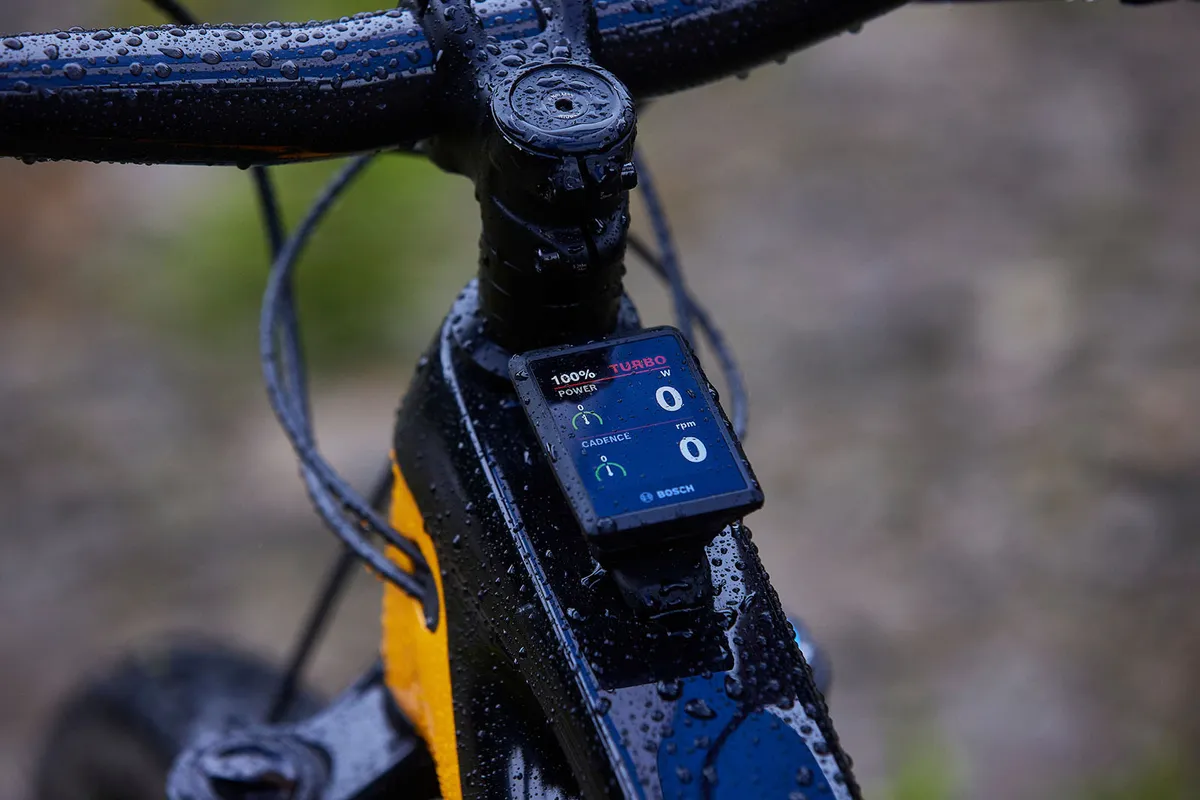
Bosch’s Performance Line CX motor and 750Wh battery fitted to Trek’s Rail now set the electric bike performance benchmark in terms of power and battery life, overtaking the frugality Shimano’s EP8 became known for.
Some people may prefer the natural-feeling assistance – that tapers off the harder you pedal – of the EP8, but I suspect most will prefer the more fulfilling and consistent power of Bosch’s motor.
In terms of range, the Trek can regularly break the 2,000m ascending mark using Tour mode, with Eco delivering even more. eMTB and Turbo modes dropped its range to 1,700m and 1,400m respectively.
The low-friction Bontrager tyres improve its range, but sacrifice other, arguably more important metrics.
Trek Rail 9.8 XT Gen 3 descending performance
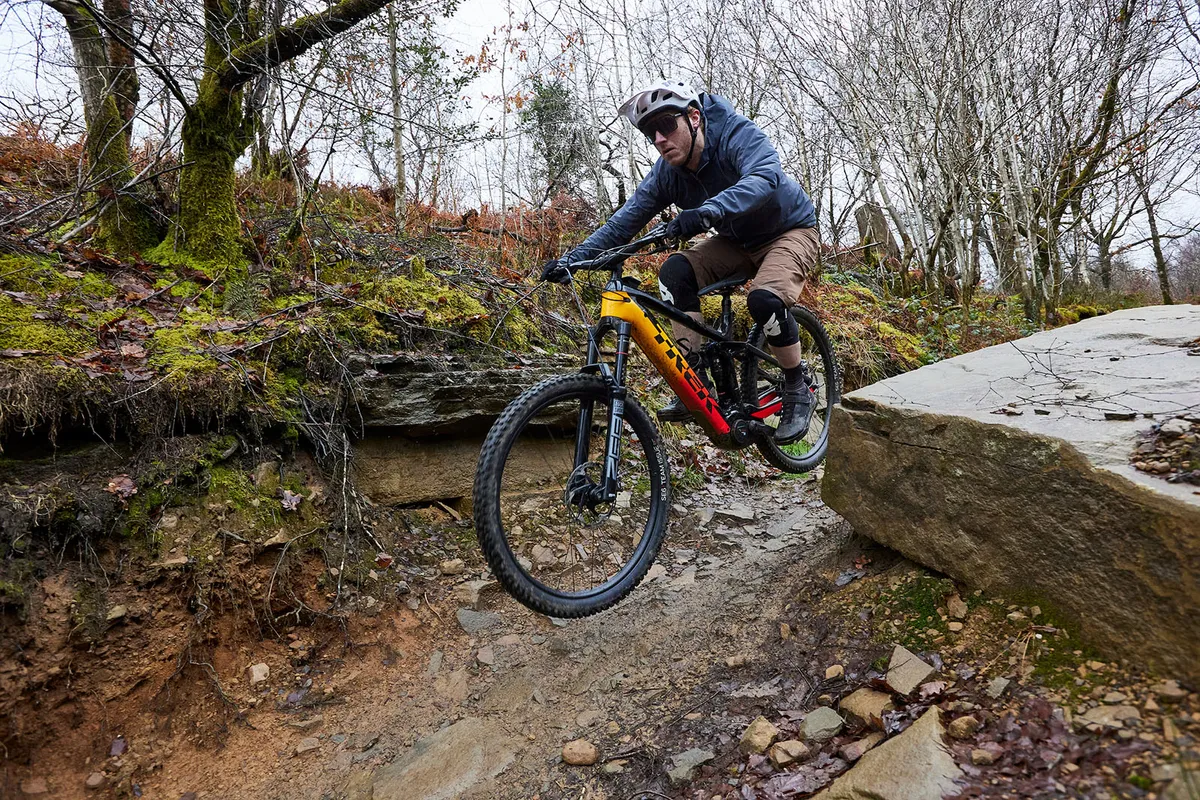
Starting with the positives, the Rail’s shape, dictated by its geometry, is spot on for gravity-focused riding. This includes the 487mm reach, low 337mm bottom bracket (measured, low-geometry setting), lengthy 448mm chainstays and enduro-ready 64.2-degree head tube angle.
Its hand-to-feet relationship is impressively balanced, distributing your weight evenly between the front and rear wheel. This reduces the size and number of potential weight shifts required to keep it on-line and helps instil confidence when speeds really increase.
Keeping your body over the centre of the bike in a neutral position feels rewarding, but also offers plenty of control without the need for continued compensatory movements.
Hammering it down straight, rough tracks is a calm rather than fraught affair.
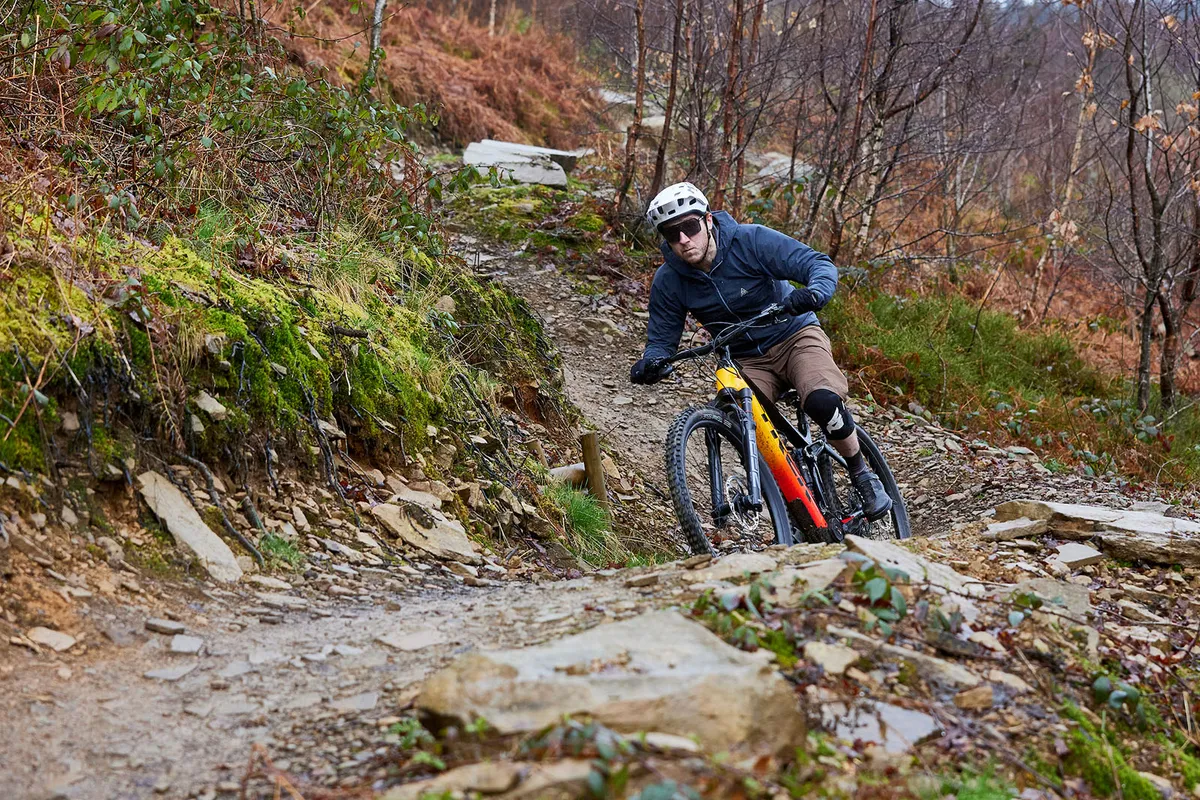
Hooking around turns also feels great, the Rail living up to its name in this respect. It happily sticks even the most extreme lean angles as if it's on tracks because your weight is distributed evenly between the wheels, helping drive grip and control.
Swapping from one edge of the tyres to the other as you change direction feels just as good, requiring little rider input.
But don’t mistake that as a lack of stability; once set around a turn, the Trek sits on its intended course, barely deviating.
With plenty of performance potential in the tank, it takes large weight shifts to either drift the back wheel or get things wrong. This boosts speed, control and fun out on the trail.
As on the climbs, its suspension works hard to deliver grip as it irons out the terrain. It remains active when you’re pedalling hard on flatter sections or hammering on the brakes.

This is a real positive of Trek’s Active Braking Pivot suspension design.
There’s plenty of mid-stroke support and pop, adding to how easy it is to change direction on the Rail. Loading the bike up results in a corresponding pushback from the suspension, helping drive quick direction changes.
This helps the Rail feel lighter than it is, its handling closer to an SL ebike or heavier non-assisted enduro bike.
More end-stroke progression would improve the Rail, reducing how hard it hits bottom-out. Increasing spring pressure or adding compression damping helps reduce bottom-outs, but sacrifices performance elsewhere, arguably where the Rail really performs well.
Adding volume-reducer spacers (that are specific to ThruShaft shocks) is another solution, but the ramp-up they create can be quite hard compared to fiddling with the suspension kinematics.
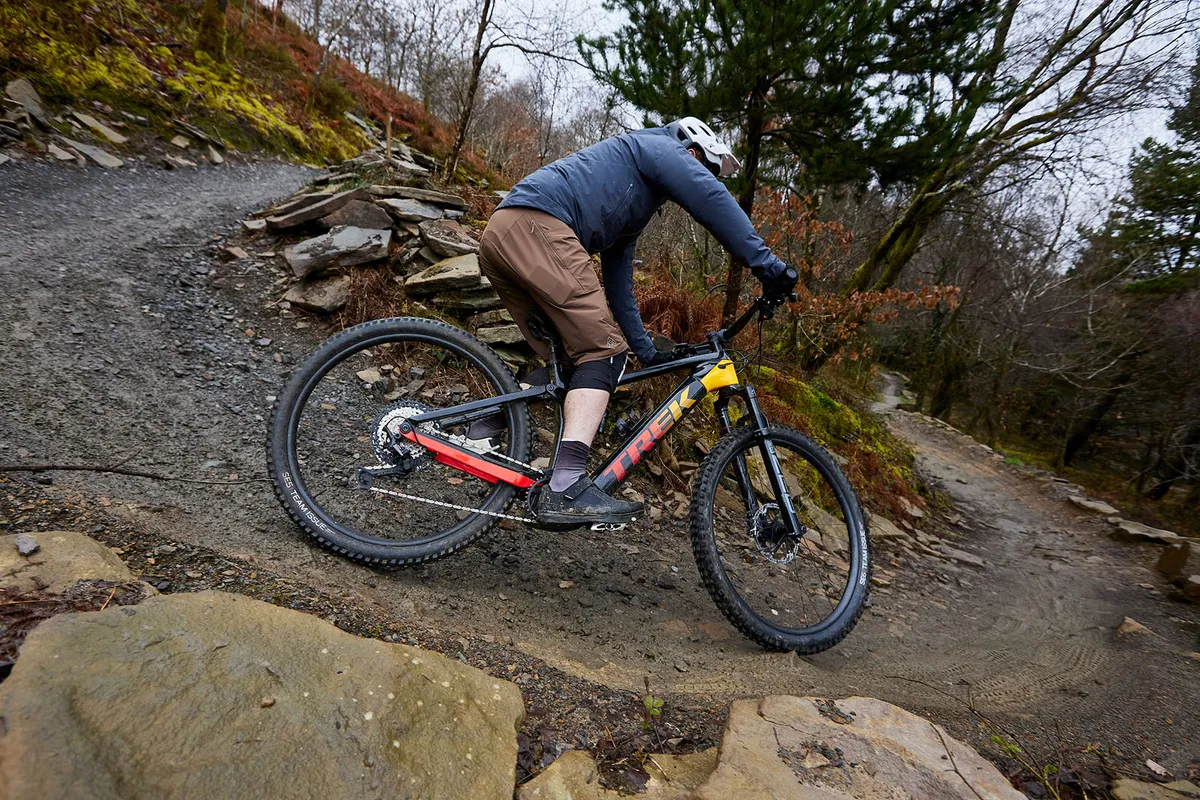
Now for the negatives.
Mimicking the feel on climbs, the Rail’s rigidity and harshness dominate over its geometry and absorbent suspension. Fatigue, hand soreness and foot cramp set in quickly on rough descents, especially compared to smoother-running electric mountain bikes.
Its tyres don’t help. Although they keep rolling speeds high, grip is limited. On the brakes, instead of digging into the ground, they skim across the top of it, sliding off embedded rocks and roots.
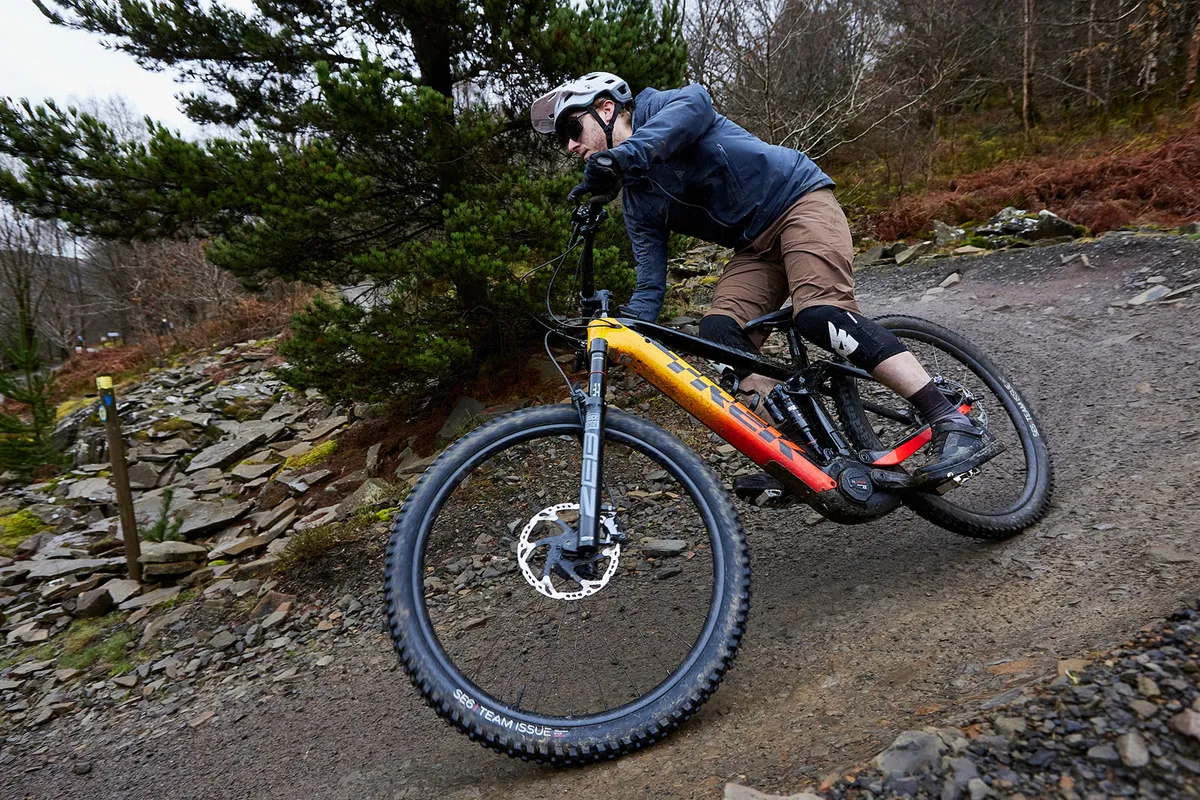
This vastly increases braking distances; you need to start slowing down much earlier compared to bikes with grippier rubber.
Even when you’re not braking, they pinball down greasy or damp tracks, shifting the bike from one line to the next.
The tyres’ grip, combined with its rigid feel, chips away at confidence, vastly reducing the Trek’s capabilities.
How does the Trek Rail 9.8 XT Gen 3 compare to the Pivot Shuttle LT 29 Ride SLX/XT?
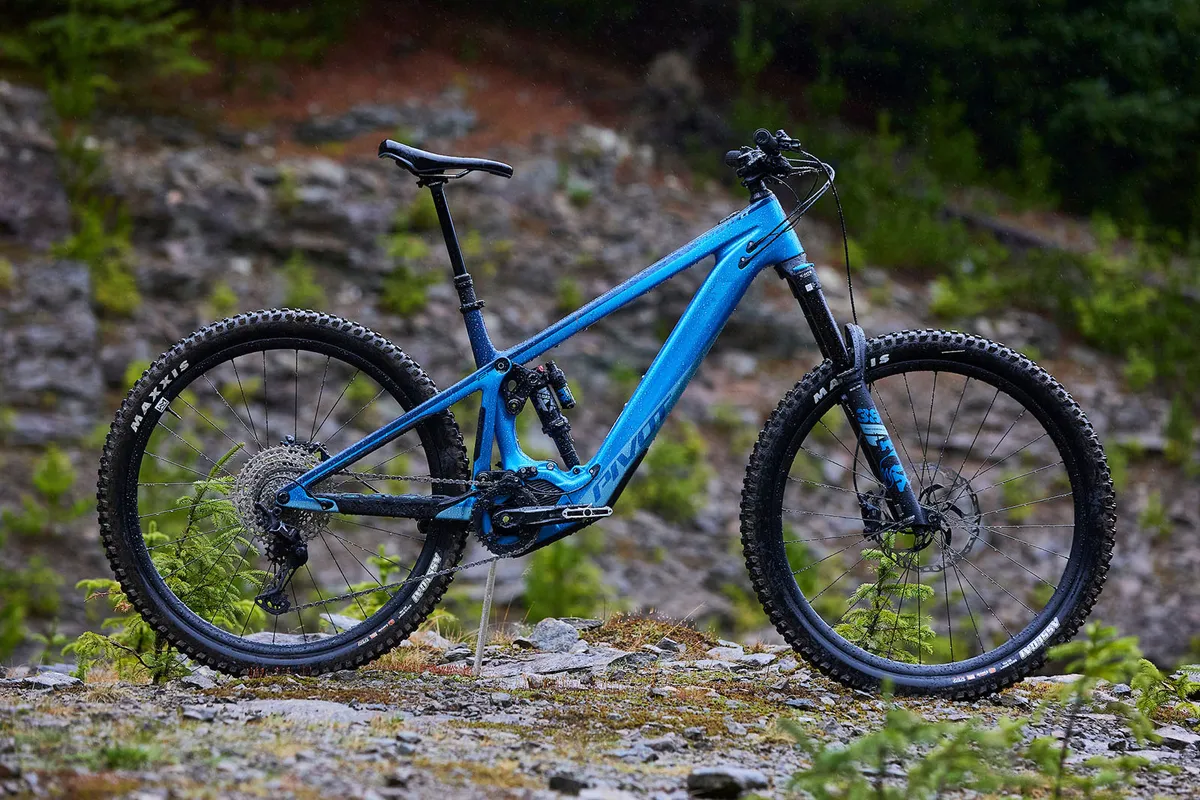
Pivot’s Shuttle LT doesn’t suffer from the same harshness as the Trek Rail. Its components – whether that’s the wheels, bars, tyres, frame or a combination of the four – offer a comfier, smoother ride.
Maxxis’ MaxxTerra tyres still have more traction than the Bontragers fitted to the Trek, too, further boosting the Pivot’s performance.
The Trek’s geometry makes it more of an all-rounder, however. It’s just as well suited to nipping in and out of tight corners as it is blasting at high speed down rough straights. The same can’t be said for the Pivot; its performance peaks on flat-out sections of trails, but it requires more rider involvement and muscle to get it to switch direction and weave down tight trails.
Trek’s Bosch motor offers more power than the Shimano, but with Pivot’s high-capacity 756Wh battery, there’s little to differentiate the two in terms of range.
Price and components are another factor, the Pivot costing more. On paper, fork specs and adjustments are similar, but the Trek’s rear shock, drivetrain and brakes are higher-level models than those fitted to the Pivot.
Deciding between the two bikes is tricky. Out the box, the Pivot performs and feels better, but the Trek has plenty of potential with a few choice upgrades, edging its cost closer to the Pivot’s £10,000 asking price.
Trek Rail 9.8 XT Gen 3 bottom line

The Rail’s tyres are its main undoing, lacking grip in a wide variety of terrain and trail conditions. They combine with the bike’s rigid feel, further reducing grip, but also knocking rider confidence.
It’s a shame because the Rail’s geometry and suspension are sorted, and there’s clearly plenty of performance potential there. However, you won’t be able to tap into that potential without swapping parts on your new bike.
Upgrades will address these issues, but the cost is going to add up quickly, potentially putting you off getting the Trek in the first place.
The Bosch motor is a big draw, however, and if you’ve got your heart set on a Trek go for it, because the Rail has the potential to be an impressive bike.
eMTB Bike of the Year 2023 | How we tested
Full-power, high-performance, gravity-focused ebikes need to behave like mini-DH bikes on the descents, but provide a comfortable, brisk and efficient means to climb back up.
A gutsy motor will do the heavy lifting when ascending, but little can mitigate poor geometry, bad spec choices and sub-standard suspension.
When searching for your perfect full-power ebike, we recommend going big on travel (150mm plus), battery capacity (630Wh or more) and motor power (85Nm or above).
Spot-on geometry will improve both uphill and downhill performance; steep seat tube angles, mid-length chainstays and slack head angles are all desirable.
Senior technical editor Alex tested eight full-power eMTBs on his home trails in Scotland's Tweed Valley, home to the UK's round of the Enduro World Cup and the 2023 XC Olympic and Marathon World Championships.
Testing happened from November to late March, subjecting the bikes to some of the harshest weather conditions known.
The pedigree and scope of the terrain on his doorstep is second to none, helping Alex push our eight bikes to their limits. Riding them back-to-back separated the strong from the weak and finally, a winner was chosen.
Our 2023 eMTB Bike of the Year contenders
- Nukeproof Megawatt 297 RS
- Orbea Wild M-Team
- Pivot Shuttle LT 29 Ride SLX/XT
- Santa Cruz Bullit SS C
- Specialized Turbo Levo Expert
- Transition Repeater NX Carbon
- Trek Rail 9.8 XT Gen 3
- Whyte E-180 RSX Super Enduro
Thanks to…
Thanks to our sponsors Crankbrothers, FACOM tools, MET helmets, Bluegrass Protection, Supernatural Dolceacqua, Le Shuttle and BikePark Wales for their support of Bike of the Year.
Product
| Brand | trek |
| Price | 12500.00 AUD,9099.00 EUR,8350.00 GBP,7500.00 USD |
| Weight | 23.9700, KILOGRAM (L) - without pedals |
Features
| Fork | RockShox ZEB Select+, 160mm (6.3in) travel |
| br_stem | Bontrager Line Pro, 35mm |
| br_chain | Shimano XT M8100 |
| br_frame | OCLV carbon fibre, 150mm (5.9in) travel |
| br_motor | Bosch Performance Line CX motor, 750Wh Powertube battery, Bosch Kiox 300, Bosch LED Remote |
| Tyres | Bontrager SE5 Team Issue Core Strength sidewalls, amarid bead 120tip 29x2.5in (f), Bontrager SE6 Team Issue Core Strength sidewalls, amarid bead 120tip 29x2.5in (r) |
| br_brakes | Shimano XT M8120, 203/203mm rotors |
| br_cranks | e*thirteen e*spec Plus, 34t |
| br_saddle | Bontrager Arvada |
| br_wheels | Bontrager Line Comp 30 |
| br_headset | Trek Knock Block 2.0 |
| br_shifter | Shimano XT M8100 |
| br_cassette | Shimano XT M8100, 10-51t |
| br_seatpost | Bontrager Line Elite (dropper) |
| br_gripsTape | Bontrager XR Trail Elite |
| br_handlebar | Bontrager Line Pro OCLV Carbon, 780mm |
| br_rearShock | RockShox Super Deluxe Ultimate RT3 DebonAir Thru Shaft 3-position damper |
| br_availableSizes | S, M, L, XL |
| br_rearDerailleur | Shimano XT M8100 (1x12) |
